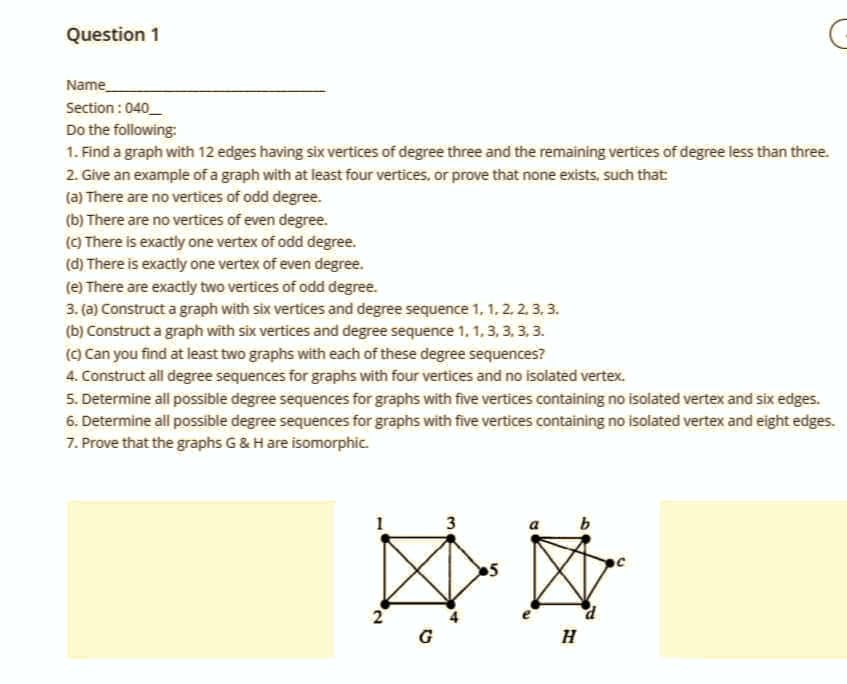7. Prove that the graphs G & H are isomorphic. 2 G 3 H b
Advanced Engineering Mathematics
10th Edition
ISBN:9780470458365
Author:Erwin Kreyszig
Publisher:Erwin Kreyszig
Chapter2: Second-order Linear Odes
Section: Chapter Questions
Problem 1RQ
Related questions
Question
MATHEMATICS IN THE MODERN WORLD
Answer onlu number 7

Transcribed Image Text:Question 1
Name
Section: 040
Do the following:
1. Find a graph with 12 edges having six vertices of degree three and the remaining vertices of degree less than three.
2. Give an example of a graph with at least four vertices, or prove that none exists, such that:
(a) There are no vertices of odd degree.
(b) There are no vertices of even degree.
(c) There is exactly one vertex of odd degree.
(d) There is exactly one vertex of even degree.
(e) There are exactly two vertices of odd degree.
3. (a) Construct a graph with six vertices and degree sequence 1, 1. 2. 2. 3. 3.
(b) Construct a graph with six vertices and degree sequence 1, 1, 3, 3, 3, 3.
(c) Can you find at least two graphs with each of these degree sequences?
4. Construct all degree sequences for graphs with four vertices and no isolated vertex.
5. Determine all possible degree sequences for graphs with five vertices containing no isolated vertex and six edges.
6. Determine all possible degree sequences for graphs with five vertices containing no isolated vertex and eight edges.
7. Prove that the graphs G & H are isomorphic.
2
**
G
3
●5
H
Expert Solution
This question has been solved!
Explore an expertly crafted, step-by-step solution for a thorough understanding of key concepts.
Step by step
Solved in 2 steps with 2 images

Recommended textbooks for you

Advanced Engineering Mathematics
Advanced Math
ISBN:
9780470458365
Author:
Erwin Kreyszig
Publisher:
Wiley, John & Sons, Incorporated

Numerical Methods for Engineers
Advanced Math
ISBN:
9780073397924
Author:
Steven C. Chapra Dr., Raymond P. Canale
Publisher:
McGraw-Hill Education

Introductory Mathematics for Engineering Applicat…
Advanced Math
ISBN:
9781118141809
Author:
Nathan Klingbeil
Publisher:
WILEY

Advanced Engineering Mathematics
Advanced Math
ISBN:
9780470458365
Author:
Erwin Kreyszig
Publisher:
Wiley, John & Sons, Incorporated

Numerical Methods for Engineers
Advanced Math
ISBN:
9780073397924
Author:
Steven C. Chapra Dr., Raymond P. Canale
Publisher:
McGraw-Hill Education

Introductory Mathematics for Engineering Applicat…
Advanced Math
ISBN:
9781118141809
Author:
Nathan Klingbeil
Publisher:
WILEY

Mathematics For Machine Technology
Advanced Math
ISBN:
9781337798310
Author:
Peterson, John.
Publisher:
Cengage Learning,

